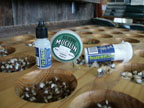
In an earlier article we covered the essential duties of a third-base coach. In this article, Ken Gamble offers three keys to ensure you become the best third-base coach you can possibly be.
There is an old (and very wise) baseball theory that you should never make the first or last out of an inning at third base. What this means is to not make the out by aggressive base running. With no outs you should always hold the runner at second base if there is any possibility of a play being made at third.
When the baserunner is on third with less than two outs be sure he understands that if the hit is a fly ball to the outfield he should stay on third and go home as soon as the ball is caught rather than risk having to retreat to third to tag up and then go home. In almost all cases there is plenty of time to run home as soon as the ball is touched.
Do not worry about whether it was caught or dropped. There should be no question in the umpire's mind that the runner was on base when the ball was first touched. The baserunner should stay on third and focus his attention on home plate and await the third base coach's shout of "GO".
Be sure that the base runner understands what you are communicating to him with your signals or words. If there is any doubt be sure that he understands that it is his responsibility to ask you again or to request time out.
Do not admonish a player for making a baserunning mistake during a game. Wait until the next practice to explain the circumstances and what you were trying to accomplish.
Remember that you want your team to be aggressive (but smart) when running the bases. One of the results of aggressive baserunning is a higher chance of being put out.
You (and your team and parents) must be comfortable with the fact that aggressive baserunning will result in some outs and must be willing to exchange those outs for the possibility of a larger amount of runs (a big inning which in most cases will decide a game).
There are times when you do all the right things and play all the correct odds but still get put out. That does not make the play any less correct. Be sure that all the players and coaches understand that. There should never be any criticism (even well-meaning) if a player and/or coach work within the framework that they establish in practice—no matter what the result.
You do not want that same player worrying about whether he will be yelled at or criticized next time he is in the same situation. That little bit of doubt could slow a player down enough to cost a run or the game.
From the start of our season we use visulization techniques to put the players in the situations where they want to be the player in the spotlight in critical situations. As the slogan on a popular baseball tee-shirt says - Bottom of the ninth, down by three runs, two outs, bases loaded, full count—No Fear! Teach your players to want that pressure and they won't disappoint you.
Obviously these are only guidelines. Each player is different. I have had some players who are baseball smart at the age of six-they are aggressive and always have the green light.
They are the players that you purposely hold up at third base with runners behind them even when there is a good chance that they could score from second base because they make the pitcher nervous—so nervous that he might give up an easy walk, a wild pitch or a hit that will win the game for your team. Other players need more guidance.
But at all times the guidance should have the goal of making each player make more decisions on his own as the season progresses. As players become more experienced you should become less vocal . The communication becomes less verbal and more through signals and most importantly—the player's own baseball knowledge.
Choosing the Best Cleats for Your Soccer Games

Montana Hatches - Fishing from the Top to the Bottom

Advantages of Travelling in a Rear Folding Camper Trailer

Copyright © www.mycheapnfljerseys.com Outdoor sports All Rights Reserved